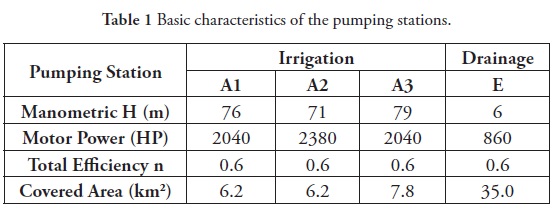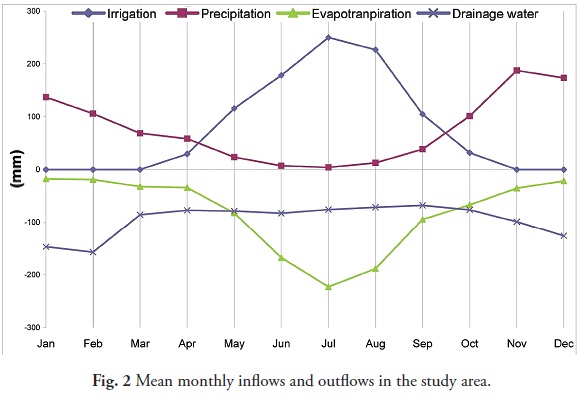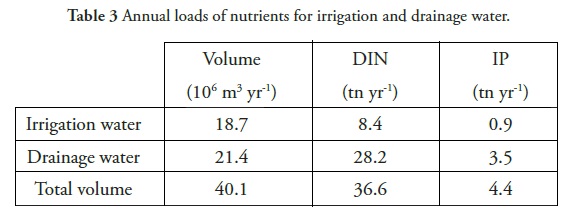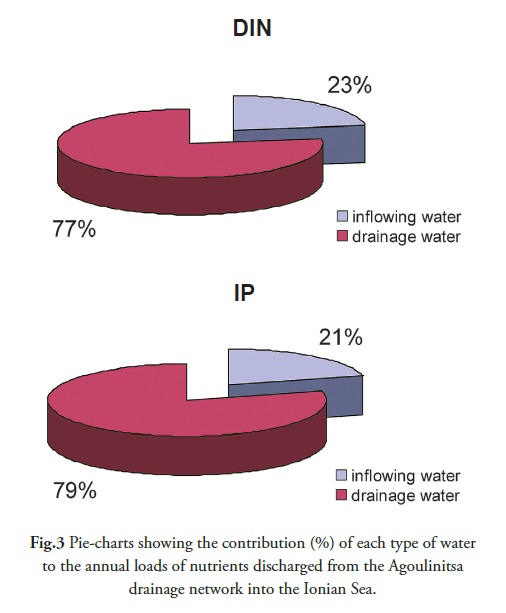Servicios Personalizados
Revista
Articulo
Indicadores
-
 Citado por SciELO
Citado por SciELO -
 Accesos
Accesos
Links relacionados
-
 Citado por Google
Citado por Google -
 Similares en
SciELO
Similares en
SciELO -
 Similares en Google
Similares en Google
Compartir
Earth Sciences Research Journal
versión impresa ISSN 1794-6190
Earth Sci. Res. J. vol.17 no.2 Bogotá jul./dic. 2013
HYDROGEOLOGY
An approximate method for estimating nutrient loads in drainage water from a coastal irrigated area
Giakoumakis S., Alexakis D. and Gotsis D.
Laboratory of Reclamation Works and Water Resources Management, School of Rural and Surveying Engineering, National Technical University of Athens, Athens, Greece
dial@survey.ntua.gr, dalexak@gmail.com
Manuscript received: 26/01/2013
Accepted for publication: 10/09/2013
ABSTRACT
In this work, an estimation of nutrient loads, expressed as Dissolved Inorganic Nitrogen (DIN) and Inorganic Phosphorous (IP), in drainage water from a coastal irrigated area was undertaken. The procedure is based on the calculation of drainage discharge with the use of data from the drainage pumping station and the assessment of the concentrations of nutrients in drainage water. The case study examined is the cultivated land of Agoulinitsa (Peloponnese - Greece). The results of this study could be useful for taking the necessary measures for environmental protection.
Key words: drainage water, nutrient loads, cultivated land
RESUMEN
En este trabajo, se emprendió una estimación de las cargas de nutrientes (expresados como Nitrógeno Inorgánico Disuelto y Fósforo Inorganico) en las aguas bombeadas desde una área de irrigación costera. El procedimiento está basado en el cálculo de descarga de la cuenca con el uso de datos desde la estación de bombeo y con la medida de concentración de nutrientes en el agua bombeada. El caso de estudio propuesto es la región cultivada de Agoulinitsa (Peloponeso - Grecia). Los resultados de este estudio podrán ser útiles para tomar las medidas necesarias para la protección del medio ambiente.
Palabras clave: Bombeo de agua; carga de nutrientes; tierra cultivada.
Introduction
Nutrients and heavy metal inputs from drainage water and surface water to the sea environment has been a major environmental concern in many regions of the world; both agricultural practices as well as land use practices are among the main factors that control the nutrient concentration and quality of water (Alexakis 2011; Brindha and Elango 2011; Gamvroula et al. 2013). In recent years, environmental studies have revealed elevated contents of nutrients in drainage water, surface water, groundwater and soil (Alexakis et al. 2014; Brindha and Elango 2011; Golekar et al. 2013). In this work, an effort was made in order to estimate both drainage water quantities and transported nutrients in an agricultural area of Greece adjacent to the sea, which suffers seriously from pollution problems of this type. The findings of this work could be useful for planning the necessary protection measures by the local authorities.
Study area
The study area is the Agoulinitsa irrigation district, the downstream part of the Alfeios river basin in the north-west Peloponnese peninsula in Greece. The irrigation network was constructed between 1960 and 1970, after the artificial draining of the Agoulinitsa lagoon. The study area lies between latitudes 37o32´-37o37´N and longitudes 21o26´-21o36´E and is located 7 km south-west of Pyrgos city. It is surrounded by the Ionian Sea in the west, with elevations ranging from 0.5 to -1.5 m below sea level, and covers approximately 35 km2 (Fig. 1). The district is irrigated using the water of the Alfeios River. Water from the main irrigation channel is distributed to three pumping stations (A1,A2,A3), which supply sprinkler irrigation. The drainage network consists of 1st, 2nd and 3rd class drainage ditches that drain excess water from the cultivated land to the sea through a drainage pumping station (E). The net irrigated area of the Agoulinitsa network is 24 km2. According to the local management authorities, the cultivated land is approximately 80 % of the net area.
The irrigation season begins in April or early May and generally ends in September or October. The most common agricultural crops are corn, cotton, alfalfa, cereals, vegetables and citrus. There is no detailed information about the amount of commercial fertilizers applied by farmers in the Agoulinitsa district. The most common type of fertilizer applied in the study area is NPK (14 % of N, 28 % of P and 14 % of K).
Soils are derived from Quaternary alluvial deposits. The Quaternary alluvial deposits cover the study area, which includes lagoonal deposits, recent delta deposits, red clays, gravel and sandy materials. Soil infiltrability varies between 0.04 and 118 mm h-1 (Gotsis, 2007).
Materials and methods
Data collection
Data were collected from literature sources and relevant databases (Alexakis et al. 2012; Public Power Corporation of Greece). Monthly precipitation and temperature data obtained from the meteorological station of N.M.S. (National Meteorological Service), which is located in Pyrgos city, were used in this study (Fig. 1).
This study uses all the available systematically collected data concerning water quality of the study area over the of the year 2010. Both irrigation and drainage water samples were collected during pre-irrigation and post-irrigation seasons. A location map of the water samples and a detailed description about the sampling campaign are given by Alexakis et al. (2012).
Inflow and outflow volumes
Electrical power for a pumping station is calculated from the following equation:
where:
P, is the electrical power (kW)
Q, is the water discharge (m3/h)
H, is the manometric head (m)
n, is the total efficiency of the pumping station
Transforming eq. 1, the electrical energy consumption for a pumping station can be calculated from:
where:
W, is the electrical energy consumption (kWh)
V, is the volume of discharged water (m3)
Monthly records of electrical energy consumption for the pumping stations (A1, A2, A3 and E) were used (Public Power Corporation of Greece/Pyrgos City). By using eq. 2, the volume of water discharged each month was calculated (i.e., irrigation water using data from pumping stations A1, A2, A3 and drainage water using data from pumping station E). The monthly discharged volume of water was then expressed in mm/month according to the data reported in Table 1.
The estimated values of the mean monthly inflows for the period of the years 2000-2010 (precipitation, irrigation water) and outflows (potential evapotranspiration, drainage water) in the study area are presented in Fig. 2.
The potential evapotranspiration losses, also shown in Fig. 2, were estimated with the use of the modified Blaney-Criddle equation (Gotsis and Giakoumakis, 2006):
where:
PET, is the potential evapotranspiration for the reference crop (clipped grass) in mm/day
T, is the mean monthly temperature (oC)
p, is the mean daily percentage of total annual daylight hours (taken from tables)
AB , BB: are the adjustment factors based on minimum relative humidity, sunshine duration and wind speed (taken from tables)
According to the crop and the month, the appropriate crop factor Kc was then selected.
Nutrient loads
The mean annual concentrations of DIN (Dissolved Inorganic Nitrogen), which is the sum of NO3-N, NH4-N and NO2-N and IP (Inorganic Phosphorous), that were used in this study were calculated based on the NO3-N, NH4-N, NO2-N, and PO43- concentrations, respectively (Table 2). The conversions between NO3- and NO3-N is the NO3- result multiplied by 0.226, while the conversions between NH4+ and NH4-N is the NH4+ result multiplied by 0.777. The recorded NO2- water contents were below the detection limits. A conversion factor of 0.326 was applied for the conversion between PO43-and P.
Because PO43- is the most readily available form of phosphorous for uptake during photosynthesis, the study of this type of phosphorous is generally of high importance with regards to algal blooms and eutrophication (Yanagi et al. 1992).
Annual loads of nutrients were then calculated by multiplying the mean annual concentrations mentioned above by the corresponding volumes of annual inflowing (irrigation) water and drainage water, respectively. The total annual loads (in tn yr-1) of DIN and IP discharged from the Agoulinitsa drainage network into the Ionian Sea were finally estimated by the following equations:
Results and Discussion
Concentrations of DIN and IP in drainage water are higher than the concentrations of DIN and IP in Alfeios surface water. This is attributed to the extensive use of fertilizers by farmers in the Agoulinitsa district. The results are shown in Table 3.
From this table, the following remarks can be outlined:
(i) The annual volume of drainage water from the study area is greater than that of irrigation water, which is percolated into the soil by sprinkler irrigation, because drainage water is also composed of runoff from precipitation.
(ii) Annual loads of DIN and IP are far greater for drainage water than for irrigation water. Namely, the contribution of inflowing water (Alfeios River water feeding the irrigation network) in the annual DIN and IP loads are 23% and 21%, respectively, whereas the contribution of drainage water in the annual DIN and IP loads are 77 % and 79 %, respectively (Fig. 3).
(iii) Total annual loads of DIN and IP discharged from the Agoulinitsa drainage network into the Ionian Sea are 36.6 tons of DIN and 4.4 tons of IP.
To contribute to the environmental protection of the sea coast and to control the nutrient loads that are discharged into the seawater, a method of reusing drainage water and mixing with freshwater for irrigation use was proposed (Gotsis et al., 2011).
Conclusions
It was found that the drainage water of the study area contains nutrients expressed as Dissolved Inorganic Nitrogen (DIN) and Inorganic Phosphorous (IP), due mainly to the extensive use of fertilizers in the cultivated land. The annual transported loads of nutrients DIN and IP discharged into the sea were calculated to be 36.6 and 4.4 tons, respectively. These findings could contribute to the establishment of the appropriate policy measures for environmental protection (i.e., drainage water reuse after mixing with fresh water).
References
Alexakis, D. (2011). Assessment of water quality in the Messolonghi-Etoliko and Neochorio region (West Greece) using hydrochemical and statistical analysis methods, Environmental Monitoring and Assessment, 182, 397-413. [ Links ]
Alexakis, D., Gotsis, D. and Giakoumakis, S. (2012). Assessment of drainage water quality in pre- and post-irrigation seasons for supplemental irrigation use, Environmental Monitoring and Assessment, 184, 5051-5063. [ Links ]
Alexakis, D., Gotsis, D. and Giakoumakis, S. (2014) Evaluation of soil salinization in a Mediterranean site (Agoulinitsa district—West Greece), Arabian Journal of Geosciences, DOI 10.1007/s12517-014-1279-0 [ Links ]
Brindha, K. and Elango, L. (2011). Hydrochemical characteristics of groundwater for domestic and irrigation purposes in Madhuranthakam, Tamil Nadu, India, Earth Sciences Research Journal. 15, no. 2, 101-108. [ Links ]
Gamvroula, D., Alexakis, D., Stamatis, G. (2013). Diagnosis of groundwater quality and assessment of contamination sources in the Megara basin (Attica, Greece), Arabian Journal of Geosciences. 6, no.7, 2367-2381. [ Links ]
Golekar, R. B., Patil, S. N. and Baride, M. V. (2013) Human health risk due to trace element contamination in groundwater from the Anjani and Jhiri river catchment area in northern Maharashtra, India. Earth Sciences Research Journal, 17, no. 1, 17 – 23. [ Links ]
Gotsis, D. and Giakoumakis, S. (2006). Update of planning variables for the irrigation network of Alfeios in Ilia. 10th Hellenic Hydrotechnical Association's Conference, Xanthi, Greece, 761-768 (in greek). [ Links ]
Gotsis, D. (2007). Estimation of irrigation and drainage planning variables for the network of Agoulinitsa with the use of experimental data, MSc Dissertation, Interdepartmental Program of Postgraduate Studies in Water Resources Science and Technology, School of Rural and Surveying Engineering, National Technical University of Athens, Greece (in greek). [ Links ]
Gotsis, D., Spiliotis, M . and Giakoumakis, S. (2011). Reuse of drainage water in irrigation with the aid of 0-1 linear programming, Irrigation and Drainage Systems, 25, no.4,385-394. [ Links ]
Yanagi, K., Yasuda, M. and Fukui, F. (1992) Reexamination of the fractionation of total dissolved phopshorous in seawater using a modified UV-irradiation procedure, and its application to samples from Suruga bay and Antarctic ocean. Journal of Oceanography, 48, 267-281. [ Links ]























